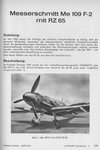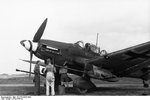- Thread starter
- #221
CharlesBronson
Senior Master Sergeant
Quote to self, page 6:
Aparently the hang shots were not caused by a mechanical unreability of the MK but for the large grain of its propellant.
It could be, I need to search more information about that apparatus.
MK 103 in FW 190:
This gun was installed in two containers below the wings. Two types of containers ( Waffenbehalter) were developed, one for the FW-190A-5 and other for the Fw-190A-8 and F-8. In both cases the gun in this emplacement was feed by a metallic belts of 32 cartrigdes. It seems that the recoil forces and vibration were too much to the Focke Wulf ( despite the strong fabrication of the Wurger wings) and just few aircraft were armed in this way.
FW-190A-8/R3 .

Teorically the electric ignition in this weapon allow to shoot through the propellers, however test with an underbelly MK was a complete failure since the variation in rate of fire caused some "hang" shots, with the predictable consecuences.
Aparently the hang shots were not caused by a mechanical unreability of the MK but for the large grain of its propellant.
How about a target/reflector in the breech end. The device on the muzzle end has cross hairs and you look thru the barrel at the target in the breech end. If perfectly centered in the muzzle device's cross hairs, you can verify straightess of the barrel.
Pure conjecture on my part.....
It could be, I need to search more information about that apparatus.
Last edited:











